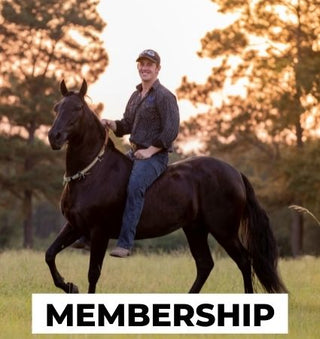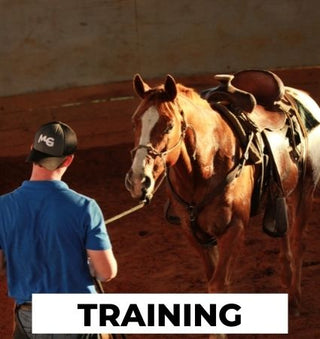Today we are talking about halter training a foal!
Watch the Video Here or continue reading below!
What’s going on Team MG! We are with you today with the foal series. A lot of you guys have been asking for more full work so we’re here with Dashie. Dashie is Blondie’s baby. Blondie is my sister’s barrel racing horse, so this is a quarter horse filly for charity. We are going to look to get her a little halter. She’s already a little friendly where she wants to come around, hang out, things like that.
Where To Start Halter Training
I have my baby MG Halter here. I’m going to go around her neck with my arms and the halter. I always like to start there and work my way forward towards the face to put it on. There we go. She might booger off when we start touching her in the face. If she does, we just follow her backwards, real gentle and quiet.
The biggest secret is that you should treat them the same as an adult horse that you want to work with. If an adult horse has never been haltered, and didn’t want to do these things, the same techniques would be used for them, as we’re going to use for this filly. Make sure our mare is okay. If you have a fussy mare, or one that’s being mareish, make sure you tie her up. Mommy’s pretty cool with things, so I don’t think we’re having too much of an issue. If that changes, I’ll tie her up so I can work with the kid.
Control The Head Control The Horse
What’s the first thing that we always want to do? Take her face and move her butt. As she moves around here in a circle, we’re just looking for her to give her face and move her butt. What we don’t want to have happen is her flip over. So, we’re being patient and gentle. Good girl, that’s a good girl! Look how it’s the exact same thing the only difference is it’s a baby.
We are just looking for her to disengage a little bit. Keeping my hand nice and low as I put a little pressure on the rope and she gives to it, that’s it, good girl.
Release Quickly
The only thing that we do a little bit better on these babies is we give them a little bit quicker release. This is because they are more likely to fall down, and we’re not trying to have that happen. We want her to have a positive experience, good girl. Every time she looks our way, we are going to release her, put pressure on her and release. Good girl! That’s a good Dashie, good girl!
Every time she faces up, we’re giving her that release very quickly. She’s going to want to face up for scratches. She already likes to be petted and touched. Now, we’re just getting her to give to pressure, that she’s never been asked to give to yet.
It’s a cute little filly, she has that heart-shaped butt, that big old booty that has a line right down the middle. She’s going to be fast. I would say Dashie is an appropriate name.
PRESSURE AND RELEASE
Again, I am just walking off looking for her face to follow from the pressure, and release. See if she’ll follow with her feet and release. Good girl. Look how we moved her front end, do the same thing again. Keep your hand nice and low as you put a little pressure on the lead, wait, wait wait, and release. Good girl! I just want her to think wherever I go that’s where she wants to go. See how everything’s down and low with my hands. Look how I am trying to keep everything low, so she doesn’t want to rear up, and then gently push her butt over as we turn in a circle.
Just as if you’re riding a colt start, now I’m starting to put a little pressure on her face. Then you can reach back here and push her butt at the same time to get her to move to pressure. Be aware, treat them just like a horse because foals kick and bite that exact same way, and it doesn’t feel awesome.
The Respect Series
So, right here I’m just leaving that rope down around her rear end as I stand off behind her. I am putting a little pressure on the lead to get her to turn around or give to me. She turned, good girl! A little pressure here looking for her to move forward, good girl, that’s it, that’s it. Everything for her first session is just the same thing that we do in horsemanship. The same thing we do in the respect series, control the head, control the horse. If we can teach her in this session just to give her face and move her butt, leading will come very shortly after.
A lot of people try to put a halter on a horse, on a foal, or any horse that’s never been haltered. Then they try to lead them right away. It doesn’t make sense to the horse because when you pull on them their first instinct is to pull against you. If you push on somebody and hold that pressure, they just want to lean against it. It’s the same thing that happens whenever you try to lead them in a straight line. Before we do that, we want to see that we can move her left and right, pull her face, and move her butt. The more of that we can do, the better we’re going to do with her.
Halter Train In The Stall
There we go, stepping right in behind her rear end to turn her to the right. Notice, I’m giving her release when she jumps up a little, and I have my hand right back on her the second her feet touch the ground. There we go, that’s it. Notice we’re doing this work right in her stall. You know you can tell it’s my sister’s horse because they have a suite, or a double stall.
Touch her face, good girl. Look how she leaned into that and moved forward with the pressure on the lead. Very nice work, come right back again put a little pressure on her butt to move away. The same thing if we’re trying to get our horse to move under saddle for the first time and they didn’t want to move. It would be about hey, can we move their face, can we move their butt?
USE A CIRCLE
Notice for those rearing things that she does. Anything like that, she has to have her feet locked out. So, every time that she sprawls and tries to lock up her back feet, if we can get those back feet crossing, she won’t be able to rear. That is why we are circling her. She won’t be able to get fussy. The softer we can get her moving her rear end the better it’s going to be. Good girl. I want her to think anytime I come to her butt, she should want to bring me her face, just like in horsemanship, just like in liberty.
She’s small enough that I don’t have to pop on her, I can just push on her. As I walk around and gently put pressure on her hip she is giving to the pressure. Here we go, now she’s getting the ideas so much better. Now let’s circle the other way while putting pressure on her hip and having her face follow us. Good girl!
The reason I like pushing and putting that physical pressure versus popping, is because the colts can get a little bit overreactive and overstimulated. If I just reach out, put a hand on her, and shift her weight a little bit, that’s going to make things happen a lot quieter and easier.
Use The Time To Desensitize
There we go, look how I let her figure it out in her face and I just moved her butt. You guys see me do this with colt starting so much that when a horse is too fussy about their face, we’ll turn and bring a crop to their butt and then they won’t worry about their face. That’s exactly what’s happening here. If I was doing all the contact in her face, she would be real fussy about that halter for the first time. I just want to pet her and desensitize her a little bit by rubbing my hands over her back and sides. That’s a good girl. She did good with that, enough that we can move her butt and she’s desensitized. We can touch her and just engage her and she’s already wanting to face up.
Just like that that’ll be the end of her session. We’ll take that halter off with the lead around her neck still. Do not let her run away just quite yet. Pet her to end on a good note, and then release her. Thank you honey, all right, go back and have your morning milk.
In Conclusion Of Halter Training A Foal
Thank you guys so much for watching, that’s as simple and easy as we can get. If you keep watching the series, that was just day one of her having a halter on her face. With us starting to control her face and move her butt. The quieter and easier that can happen, the quicker the leading of a baby’s going to happen. We know if they can’t lock up their back end, then they can’t lock up on us. As long as we can move their face and their butt, we’ll be able to get her to move. The same way we started her basically leading in a circle, where she was looking at me.
Very quickly that’s going to move to her walking in a straight line. Every time she gets stuck, we’ll just start walking her in a circle. Whenever she is willing to go forward, we’ll walk off in a straight line. That’s going to be easier for her very quickly over the next couple videos. You’ll see how finished she’ll be able to get with the halter on. Thank you guys so much, that’s our whole series!
Check out more free training resources HERE!









